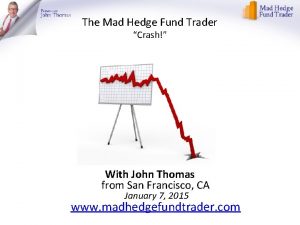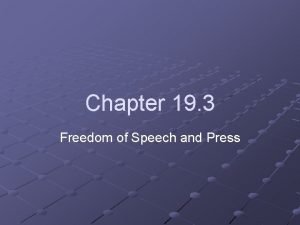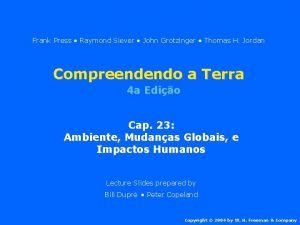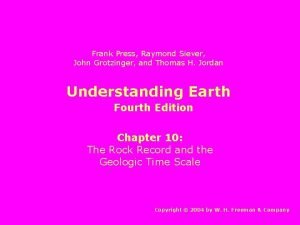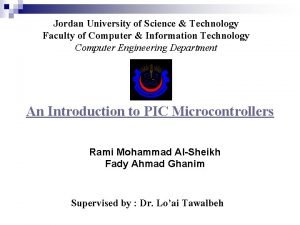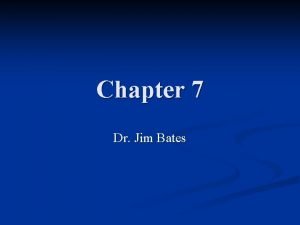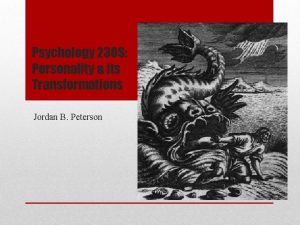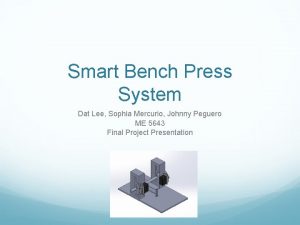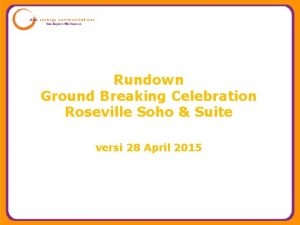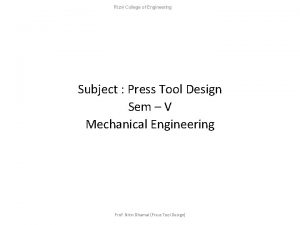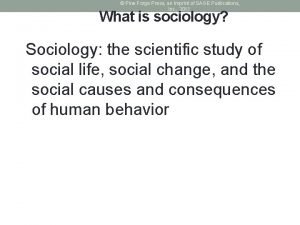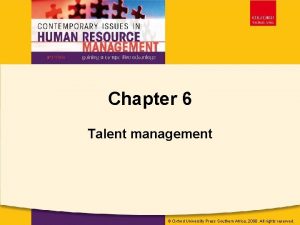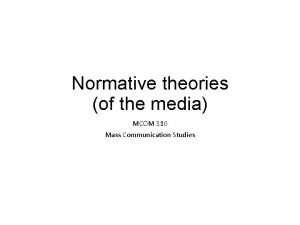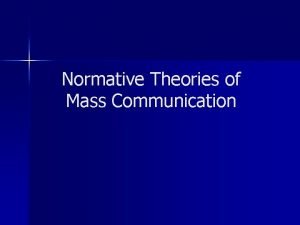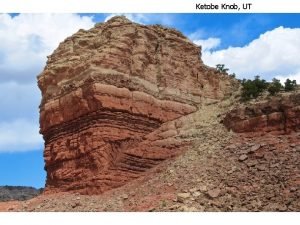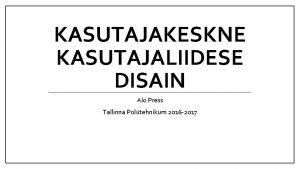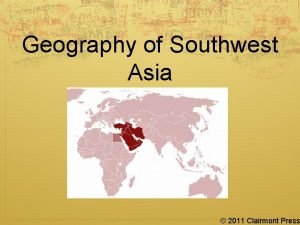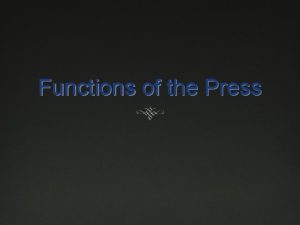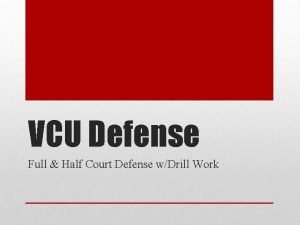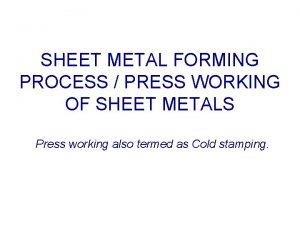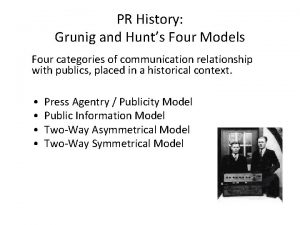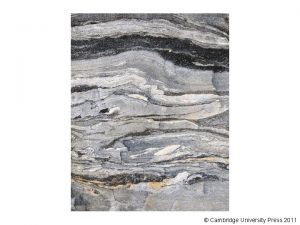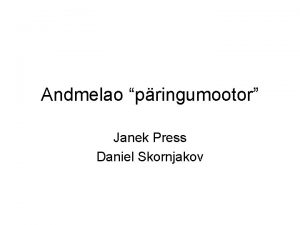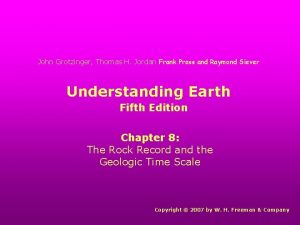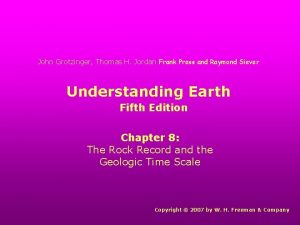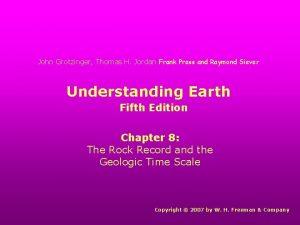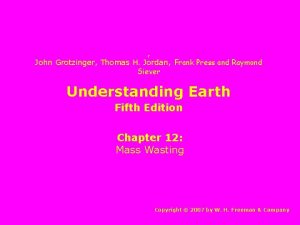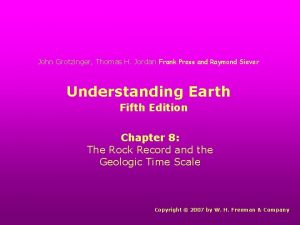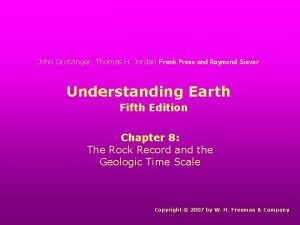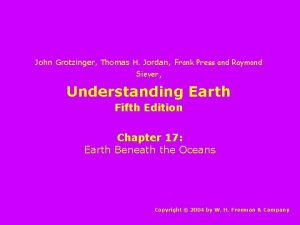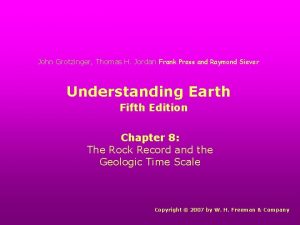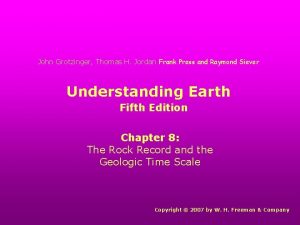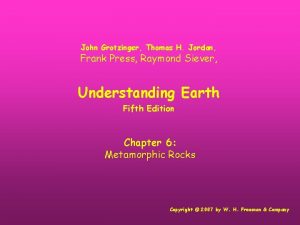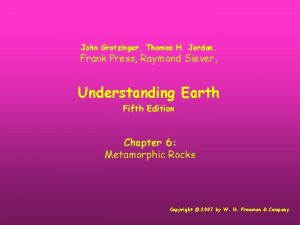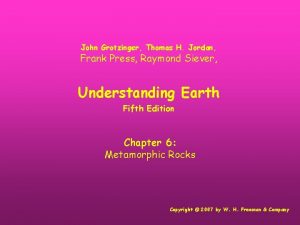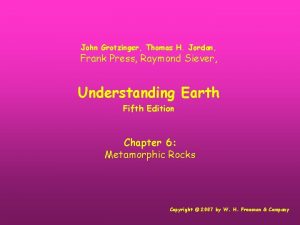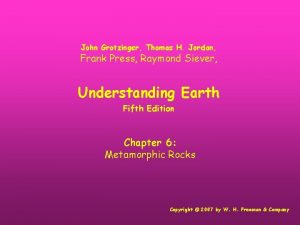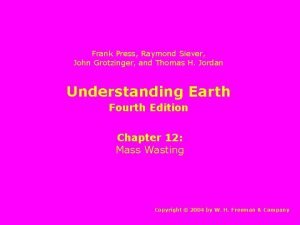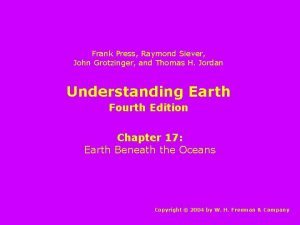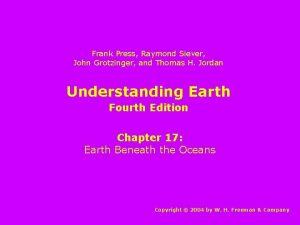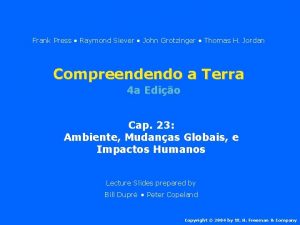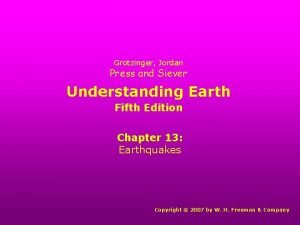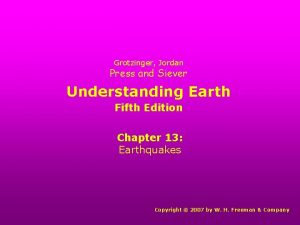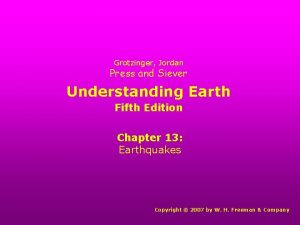John Grotzinger Thomas H Jordan Frank Press and










































































- Slides: 74

John Grotzinger, Thomas H. Jordan, Frank Press, and Raymond Siever Understanding Earth Fifth Edition Chapter 19: Earthquakes Copyright © 2007 by W. H. Freeman & Company

• Tsunami • Magnitude 10. 5?

What is an Earthquake? ? An earthquake is caused by a sudden rupture (break) of the earth An earthquake generates vibrations that travel through the earth, a. k. a earthquake waves

1906

Why do Earthquakes happen? • Plate Motion

How do earthquakes occur? Elastic Rebound Theory is one explanation of how earthquakes take place.

Elastic Rebound Theory • Pressure or stress, builds up in the rock, much like a bending rubber eraser in your hands. • You can break a rubber eraser if the pressure or stress you apply to it exceeds the natural strength of the rubber.

Elastic Rebound Theory • There are two important concepts you should be aware of. Stress in earth sciences refers to the pressure the rock experiences and strain is the actual damage or resultant deformation that we can measure. • While the pressure builds up in the rock DOES deform or strain. However, it does so elastically. That is if you release the rock from under stress it will BOUNCE back without any signs of damage. Normal rocks are usually only able to take a small (1 -2%) of elastic strain. Stretching or thinnning beyond 1 -2% can cause permanent damage.

Elastic Rebound Theory • When the rock breaks or ruptures some of the energy goes into breaking the rock and a lot of it goes into moving the surround rocks. • The rupture itself may remain buried, invisible underground (a blind fault). A rupture may or may not reach the surface. • After the stress or pressure is release the rock seals ahd again starts to accumulate stress.


Elastic Rebound Theory • Ruptures or breaks in the rock are planar cracks that grow in all directions • The rupture itself may remain buried, invisible underground (a blind fault). A rupture may or may not reach the surface.





Foreshocks and Aftershocks are smaller earthquakes that precede and postdate the main shock. What is a foreshcok or aftershock depends on when the main shock comes. But, this is really only known AFTER the big earthquake occurs!


The “EARTHQUAKE GAME” -- 1988 A seismograph is a tool that measure ground motion. During the 1988 Auburn-LSU football game LSU scored a late and winning touchdown. The crowd cheered so loduly that the “earthquake game” made local history because the ground motion appeared on the LSU seismograph.

Seismograph A seismograph consists of a real or virtual mass that is so large that it moves totally out of “sync” with the frequency of the ground motion, that is as IF IT WERE STILL. The mass is not actually still but its large inertia allows the faster motions of the earthquake groundshake to be registered accurately.


3 Types of Earthquake waves • (P and S) When an earthquake occurs it starts at depth, in the BODY of the earth. At depth there are only two types of particle motion possible. (P and S waves) P and S waves are known as BODY waves because they always originate inside the earth. These are not the most damaging but they are the first to be detected because they travel at very fast speeds ( e. g. >6000 m/s. )

3 Types of Earthquake waves • P waves are the fastest, and first waves to arrive. S waves are the second fastest (~50%) and Surface waves (45%) are the slowest of the three major types of earthquake waves.



3 Types of Earthquake waves • (Surface) The most damaging earthquake vibrations occur when the P and S waves reach the surface. There they convert into horizontal S waves and a combination of S and P waves called Rayleigh waves.


The focus of an earthquake is the origin at depth of that earthquake. The closest place on the surface of the earth to the focus is called the epicenter. An epicenter is located by triangulating between 3 or more seismograph stations, using the arrival times of two or more of the 3 types of earthquake waves.




Size of an Earthquake An earthquake size can be determined qualitatively or quantitatively and there is an equivalence between the two types of scales.

Size of an Earthquake (1) The Modified Mercalli Intensity scale describes the perceived intensity and damage, in 12 degrees, of the shaking and is useful when there are no seismographs, as in historical earthquakes (e. g. New Madrid 7. 5, 1811, Missouri). Damage depends on whethere are people to witness the earthquake effect and on local conditions.




Size of an Earthquake (2) The quantitative measure of the strength of anearthquake is the moment magnitude. Momemnt magnitude is proportional to the logarithm of the area faulted and seismic energy released during the rupture. It can be measured directly from the seismograms.


ACTIVE FAULTS GENERATE EARTHQUAKES (1) Earthquakes generate different first motions in different directions depending on the type of fault that generates the earthquake. • A first motion for a normal fault in a horizontal direction is OUT from the fault during the rupture. These tend to occur along divergent plate marginboundaries.


ACTIVE FAULTS GENERATE EARTHQUAKES (2) Earthquakes generate different first motions in different directions depending on the type of fault that generates the earthquake. • A first motion for a thrust fault in a horizontal direction is IN to the fault during the rupture. These tend to occur along convergent plate margin boundaries.


ACTIVE FAULTS GENERATE EARTHQUAKES (3) • A first motion for a strike-slip fault in a horizontal direction is IN to the fault in certain orientations and OUT from the fault in other orientations. The first motion changes every 90 degrees around the epicenter.



Frank Press, Raymond Siever, John Grotzinger, and Thomas H. Jordan Understanding Earth Fourth Edition Chapter 19: Earthquakes Copyright © 2004 by W. H. Freeman & Company





























 Forensic anthropologist vs forensic pathologist
Forensic anthropologist vs forensic pathologist Frank william abagnale jr. young
Frank william abagnale jr. young David john frank
David john frank John locke vs thomas hobbes
John locke vs thomas hobbes John adams vs thomas jefferson venn diagram
John adams vs thomas jefferson venn diagram James robinson inventor lunch pail
James robinson inventor lunch pail John thomas mad hedge fund
John thomas mad hedge fund Mad hedge fund trader
Mad hedge fund trader Hobbes
Hobbes John locke vs thomas hobbes
John locke vs thomas hobbes Chapter 19 section 3 freedom of speech and press
Chapter 19 section 3 freedom of speech and press Chapter 19 section 3 freedom of speech and press
Chapter 19 section 3 freedom of speech and press Telephone television radio and the internet
Telephone television radio and the internet Atmosfera terrestre
Atmosfera terrestre Press and siever
Press and siever Jordan university of science and technology
Jordan university of science and technology Jordan university of science and technology ranking
Jordan university of science and technology ranking Jordan university of science and technology
Jordan university of science and technology Gaussian elimination
Gaussian elimination Why is myrtle wilson upset when she sees tom and jordan
Why is myrtle wilson upset when she sees tom and jordan Custom reader joseph rychlak
Custom reader joseph rychlak Jordan food and drug administration
Jordan food and drug administration Wmpress
Wmpress Dipping method of wax pattern
Dipping method of wax pattern Thermal press hair
Thermal press hair Penny press newspaper
Penny press newspaper Eight dollars are the price of a movie these days
Eight dollars are the price of a movie these days Hmt hettstedt
Hmt hettstedt Smart bench press
Smart bench press Drill press safety poster
Drill press safety poster Rundown press conference
Rundown press conference Press tool design
Press tool design Ravne presses
Ravne presses Pine forge press
Pine forge press Maria press
Maria press Siaran pers disebut juga
Siaran pers disebut juga Piramida terbalik press release
Piramida terbalik press release Phk buku ub press
Phk buku ub press Oxford university press south africa
Oxford university press south africa Theories of the press
Theories of the press Normative theory of mass communication
Normative theory of mass communication Normative theory of mass communication
Normative theory of mass communication Similar images
Similar images Alo press
Alo press Hp indigo 3550 digital press
Hp indigo 3550 digital press Press release subhead
Press release subhead Oxford university press answer
Oxford university press answer Health administration press
Health administration press Olive press gethsemane
Olive press gethsemane Clairmont press
Clairmont press Sentry function of journalism
Sentry function of journalism Freedom of press definition
Freedom of press definition Yuo have hit the spacebar
Yuo have hit the spacebar Uniaxial pressing
Uniaxial pressing Zaalhockey press
Zaalhockey press Whats a press conference
Whats a press conference Diamond press breaker
Diamond press breaker Ios press journals
Ios press journals Solemar commercial press
Solemar commercial press Lancing operation in sheet metal
Lancing operation in sheet metal Thema murray
Thema murray Contoh backgrounders perusahaan
Contoh backgrounders perusahaan How to write press release headline
How to write press release headline Press on sermon
Press on sermon Press esc to exit
Press esc to exit Two-way asymmetrical model
Two-way asymmetrical model Role of news media
Role of news media Zaalhockey dobbelsteen
Zaalhockey dobbelsteen Szkło emaliowane press glass
Szkło emaliowane press glass How has the printing press impacted society today
How has the printing press impacted society today Shear press kinematic diagram
Shear press kinematic diagram Cambridge university press 2011
Cambridge university press 2011 Press breakers
Press breakers Gutenberg printing press ap world history
Gutenberg printing press ap world history Daniel skornjakov
Daniel skornjakov







